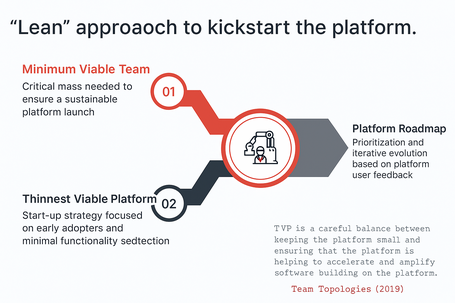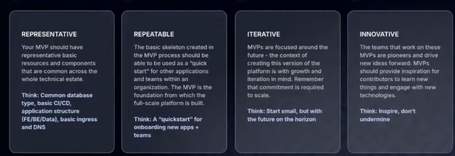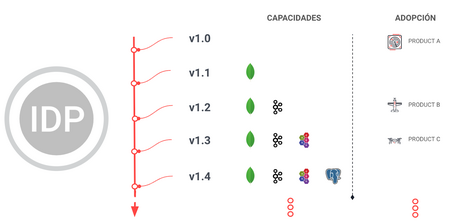Successfully starting with Platform Engineering requires careful planning and strategic execution.

The essential elements to start the initiative are:
- (MVPT) A minimum viable platform team.
- (TVP) A thinnest viable platform.
- A roadmap for the platform.

Here’s how to get started with the right team, a strong initial platform iteration, and a well-defined roadmap.
An initial Platform Team
To effectively kickstart your platform, it’s essential to establish a Minimum Viable Platform Team (MVPT). This concept centers on creating a unified team with the right composition and sufficient size to ensure the platform's sustainable evolution and growth from its inception.
The MVPT should embody both "minimum" and "viable" aspects. It needs to be the smallest, most efficient team necessary to initiate and maintain the platform, while still being agile and responsive to feedback. This team must be adequately staffed to cover the core responsibilities required to build and sustain the platform without becoming overly large or cumbersome.
Beyond ensuring the team has the critical mass needed for the initial platform development, the key characteristics of a Minimum Viable Platform Team include:
- Clear Responsibilities
Each member of the MVPT should have a well-defined role and a clear understanding of their responsibilities. This clarity helps prevent overlap and confusion, ensuring that all aspects of the platform are effectively managed.
- Initial Focus on Core Capabilities
The MVPT should initially concentrate on delivering core capabilities that offer immediate value to the organization. This may include automating development environments, setting up continuous integration pipelines, or integrating security practices into the development lifecycle. Once these foundational elements are established, the team can gradually expand the platform’s capabilities.
- Collaboration with Other Teams
Although the MVPT is focused on the platform, it must maintain close collaboration with stream-aligned teams and other stakeholders. Regular feedback loops and open communication channels are vital to ensure that the platform evolves in alignment with the needs of its users.
- Sustaining Evolution and Growth
As the platform grows and matures, the MVPT must be prepared to scale and adapt. This involves:
- Scaling the Team: As the platform’s scope expands, the team may need to grow by adding specialists or handling increased complexity. This growth should be managed carefully to maintain the team’s agility and responsiveness.
- Iterative Development: The platform should evolve iteratively, with the team regularly reviewing and refining its features based on user feedback and performance metrics. This iterative approach ensures that the platform remains relevant and continues to deliver value as organizational needs change.
- Culture and Mindset
The MVPT should embrace a culture of product delivery and continuous improvement, viewing the platform as a constantly evolving product. This mindset encourages the team to seek opportunities for optimization and innovation, with the ultimate goal of maximizing platform adoption.
First Platform Iteration
When launching the first iteration of a platform, it’s crucial to adopt a lean approach that balances simplicity with the need to deliver tangible value. Industry thought leaders consistently advocate for starting small and iterating quickly, a concept encapsulated by the "Thinnest Viable Platform" (TVP).
In 2019, the Team Topologies book introduced the concept of the Thinnest Viable Platform, which emphasizes maintaining a minimal platform while ensuring it accelerates and simplifies software delivery for the teams that rely on it. The goal of this initial platform version is to demonstrate its viability and benefits, capture feedback, and generate interest from key stakeholders—champions, influencers, and pioneers within the organization.
Key Strategies for the First Platform Iteration
- Focus on Demonstrating Value Early
- Identify Pain Points: A successful first iteration should address specific pain points within the organization. Begin by identifying one or a few critical issues that are hindering software delivery, such as bottlenecks in the deployment pipeline, inconsistencies in development environments, or delays caused by manual processes. By solving these issues, the platform can quickly prove its value and gain support from stakeholders.
- Target the Delivery Stream: Focus on the delivery stream, particularly the factors that are slowing down the time to ship features to production. Analyze the main culprits impacting lead time, such as inefficient testing processes, slow build times, or manual deployment procedures, and design a solution that the platform can offer.
- Embrace a Product Mindset from the Start
- Iterative Growth: Avoid complexity by adopting an iterative growth approach. Start with a minimal, focused platform that addresses the most pressing needs. Iterate quickly, incorporating user feedback to refine and expand the platform. This approach not only reduces the risk of over-engineering but also ensures that the platform evolves in direct response to real user needs.
- User-Centric Design and Golden Paths: The platform should be designed with its users in mind, prioritizing the creation of Golden Paths—standardized, best-practice workflows that guide developers through common tasks. Instead of taking a purely technical approach, focus on your internal customers (developers and other stakeholders) and how the platform can make their work more efficient and enjoyable.
- Engage a Broad Audience
- Onboard Key Stakeholders: While developers are the primary end-users of the platform, it’s important to onboard other stakeholders as well, including security teams, operations, and business leaders. Engaging these groups early on ensures that the platform meets broader organizational needs and garners wider support.
- Demonstrate Quick Wins: Involve champions and influencers within the organization by demonstrating quick wins that highlight the platform’s impact. Show how the platform can reduce time-to-market, improve developer productivity, or enhance security practices. These early successes can help build momentum and drive broader adoption of the platform.
From a design perspective of that first iteration on the platform, you can take inspiration from:

A Roadmap for the Platform
The mission of a platform roadmap is to maximize platform adoption across the organization. The more products that are onboarded onto the platform, the more its benefits—such as consistency, efficiency, and scalability—will be realized.
To achieve this, the roadmap must focus on two main axes: capabilities and products.
- Target Capabilities: Capabilities refer to the core functionalities that the platform offers, such as automated deployment pipelines, integrated security scanning, or standardized development environments. These capabilities enable products to adopt and thrive on the platform.
- Target Products: Products are the software applications or services that are developed and deployed using the platform. The more products that leverage the platform, the more value it delivers to the organization.
There are different strategies for designing a platform roadmap, each with its own focus and trade-offs:
- Capability-Focused Roadmap
- Strategy: This approach prioritizes the development and rollout of the most used or high-impact capabilities. The goal is to maximize the number of products that can use a specific capability, thereby accelerating platform adoption across a wide range of products.
- Advantages: This strategy quickly expands the platform’s footprint by enabling more products to start leveraging specific capabilities.
- Challenges: However, a product typically requires several capabilities to meet compliance and non-functional requirements, such as security, performance, and scalability. Focusing on just one or a few capabilities might leave products partially onboarded, unable to fully benefit from the platform, and potentially stuck in a non-production-ready state.
- Product-Focused Roadmap
- Strategy: This approach prioritizes the complete onboarding of specific products onto the platform. The roadmap is designed to ensure that all the required capabilities for a particular product are fully developed and production-ready, allowing the product to be fully compliant and operational on the platform.
- Advantages: This strategy ensures that products are fully compliant, meet all necessary non-functional requirements, and are ready for production. It creates strong use cases and showcases the platform’s potential.
- Challenges: The downside is that this approach might slow down overall platform adoption for other products, as resources are concentrated on bringing one product fully onboard before moving to the next. Not having the full picture when designing the roadmap can lead to a misalignment between platform capabilities and product needs.
- Combined Approach: Balancing Capabilities and Products
- Strategy: The combined approach seeks to balance the two axes by drawing a roadmap that delivers capabilities tailored to a flagship product while also enabling gradual adoption for other products. This strategy ensures that a prioritized product is fully onboarded, compliant, and production-ready, while also laying the groundwork for broader adoption across the organization.
- Advantages: This approach maximizes the platform's adoption potential by ensuring that key products are fully operational on the platform while steadily expanding the platform’s capabilities to support a wider range of products. It creates a path for both immediate success with flagship products and long-term growth as more products are gradually onboarded.
- Challenges: The combined approach requires careful planning and resource allocation to ensure that both axes are effectively balanced. There’s a risk of spreading resources too thin if not managed carefully.

If you’re interested in Platform Engineering and want to keep diving deeper into this topic, here’s some content you might find interesting:
- What Platform Engineering is (and what it isn’t)
- Core Elements of Platform Engineering
- Key Benefits of Platform Engineering
- Barriers to Adoption of Platform Engineering
- How to Release a Platform as a Product?
- Understanding Golden Paths: A Practical Guide
In the next post, we’ll dive into how to measure success in Platform Engineering. Stay tuned!
Comments are moderated and will only be visible if they add to the discussion in a constructive way. If you disagree with a point, please, be polite.









Tell us what you think.